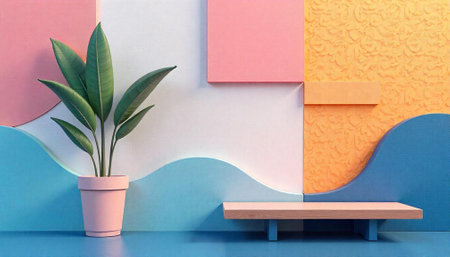Understanding Colour Psychology in Indian Homes
Colour plays a significant role in shaping the atmosphere and energy of Indian homes, deeply intertwined with cultural values and traditional beliefs. In India, each colour carries unique symbolism and emotional impact, influencing how people feel within their living spaces. For instance, yellow is often associated with warmth, happiness, and optimism, making it a popular choice for living rooms and kitchens. Red, a colour linked to passion and auspiciousness in Indian culture, is frequently used during festivals and weddings but can also energize spaces when used thoughtfully. Cool shades like blue and green are considered calming and soothing, ideal for bedrooms or meditation areas to promote relaxation and mental peace. Furthermore, white symbolises purity and simplicity, commonly seen in puja rooms or places meant for contemplation. By understanding the psychological effects of different hues and respecting local preferences rooted in centuries-old traditions, homeowners can create interiors that not only reflect their personalities but also support mental wellness. Integrating these colour choices thoughtfully ensures that your home remains a sanctuary for emotional balance and positive energy.
2. Vastu Shastra Basics for Interior Spaces
Understanding Vastu Shastra is essential for every Indian homebuyer and homeowner seeking to boost mental wellness through interior design. Rooted in ancient Indian traditions, Vastu Shastra guides the spatial arrangement and directional placement of rooms, furniture, and décor to harness positive energies. When properly applied, these principles can significantly enhance peace of mind, productivity, and emotional balance within your living environment.
Core Principles of Vastu for Interiors
Vastu emphasizes the significance of each direction and its governing element. By aligning interior spaces according to these principles, you invite harmony and well-being into your home. Below is a table summarising the ideal room placement according to Vastu:
| Room/Area | Ideal Direction | Vastu Rationale |
|---|---|---|
| Main Entrance | North-East or East | Brings prosperity and positive energy into the home |
| Living Room | North or East | Ensures social harmony and vibrant atmosphere |
| Bedroom (Master) | South-West | Promotes stability, restful sleep, and strong relationships |
| Kitchen | South-East | Represents Agni (fire); supports health and nourishment |
| Pooja Room (Prayer Room) | North-East | Enhances spiritual growth and mental clarity |
| Study/Workspace | West or North-East | Aids concentration and knowledge retention |
The Role of Spatial Arrangement in Mental Wellness
A clutter-free space aligned with Vastu not only makes interiors more functional but also uplifts your mental state. For example, placing heavy furniture in the South-West corner roots the energy of the house, while keeping the North-East area open allows free flow of cosmic energy. Regularly clearing out unused items further helps reduce stress and anxiety.
Cultural Context: Why Indians Trust Vastu for Wellbeing?
For generations, Indian families have relied on Vastu as more than superstition—it’s a time-tested system that blends tradition with well-being. In today’s fast-paced life, adhering to these age-old principles provides a sense of control and comfort, especially when combined with colour psychology for holistic wellness. Incorporate these basics when designing or renovating your home to experience lasting positivity and mental peace.
![]()
3. Integrating Colour and Vastu for Mind Wellness
In the Indian context, mental wellness is deeply rooted in both traditional wisdom and modern science. To design interiors that truly support the emotional health of Indian families, it is essential to blend colour psychology with Vastu Shastra principles. This integration goes beyond aesthetics—it creates spaces that are nurturing, balanced, and supportive of overall well-being.
Understanding the Synergy Between Colour Psychology and Vastu
Colour psychology explains how different hues affect mood and behaviour, while Vastu Shastra provides guidelines on energy flow and spatial arrangement. For example, blue is known for its calming properties in colour psychology and is also considered auspicious for bedrooms and meditation rooms according to Vastu. By aligning such colour choices with correct room orientation as per Vastu, you enhance tranquility and mental clarity.
Practical Tips to Harmonise Colours with Vastu Directions
Start by assessing each room’s direction using a traditional compass or smartphone app. In the North-East (Ishan Kon), which governs clarity and new beginnings, use light yellow or off-white shades—both recommended by psychologists for positivity and by Vastu experts for purity. South-East (Agni Kon), associated with fire and energy, benefits from gentle reds or orange tones in moderation; these colours uplift mood without overwhelming the senses.
Catering to Indian Family Needs Through Customisation
Indian families often share multi-generational spaces, so it’s crucial to consider everyone’s comfort. Use soothing greens in family living rooms facing East to encourage growth and harmony—a balance endorsed by both colour experts and Vastu texts. For children’s study areas in the West, opt for subtle blues or greens to boost concentration and calmness.
Final Thought: Intentional Design for Everyday Wellbeing
Combining colour psychology with Vastu allows homeowners to create interiors that feel intuitively right—spaces where energies flow freely and colours subtly influence mood towards peace, happiness, and productivity. By respecting both scientific insight and cultural tradition, your home becomes a true sanctuary for mental wellness, tailored specifically to the unique needs of Indian life.
4. Popular Indian Colour Palettes for Each Room
Living Room: Welcoming Warmth Meets Modern Chic
For the living room, where family gathers and guests are entertained, colours should evoke positivity and hospitality. In Indian homes, earthy tones like terracotta, beige, and soft gold remain timeless, reflecting both tradition and vastu principles. However, modern tastes also favour muted greys or pastels for a contemporary twist. Accent walls in deep blue or olive green bring sophistication and harmony. Decor choices include handloom cushions, brass artefacts, and traditional wooden furniture balanced with minimalist décor for a fresh yet rooted feel.
| Vastu Direction | Recommended Colours | Decor Suggestions |
|---|---|---|
| North-East | Light Yellow, White | Buddha statues, indoor plants |
| South-West | Earthy Browns, Beige | Wooden frames, ethnic rugs |
| East/West | Pale Blue, Olive Green | Cane chairs, brass lamps |
Puja Room: Sacred Serenity & Spiritual Energy
The puja room is the spiritual heart of an Indian home. According to vastu and colour psychology, pure whites, calming creams, or light yellows are ideal for promoting peace and focus during prayers. Traditional motifs—such as lotus patterns or mandalas—can be painted on walls or added through wall hangings. Brass diyas (lamps), marigold garlands, and marble idols enhance the sacred ambience while respecting cultural aesthetics.
Bedroom: Restful Retreats with Personal Touches
Bedrooms in India blend restful vibes with vibrant accents. Soothing shades like pastel pinks, lavender, or soft blues create a calming effect ideal for relaxation. For couples’ bedrooms, vastu suggests earthy greens or rose tones to encourage harmony. Statement headboards with Rajasthani block prints or embroidered throws add personality without overwhelming the senses. Minimal clutter and use of natural materials help maintain tranquility.
| User Type | Main Colour Palette | Traditional Accent Ideas |
|---|---|---|
| Single Adults/Teens | Soft Blue, Lavender | Madhubani art frames, dreamcatchers |
| Couples/Families | Pale Green, Dusty Rose | Kalamkari bedsheets, hand-painted lampshades |
Kitchen: Vibrant Energy for Healthy Living
Kitchens in Indian homes buzz with activity and flavours. According to vastu shastra, warm hues such as yellow, orange, or cream stimulate appetite and positive energy. Modern kitchens can incorporate glossy whites or mint green cabinets for a chic look while retaining a bright ambience. Decorate with copper utensils on display shelves, colourful ceramic jars for spices, and a touch of greenery from tulsi (holy basil) pots.
| Vastu Direction | Main Wall Colour Choices | Modern + Traditional Decor Ideas |
|---|---|---|
| South-East (Agni corner) | Lemon Yellow, Light Orange | Copper pans hung decoratively; terracotta spice jars |
| North-West/East Facing Kitchens | Creamy White, Mint Green | Bamboo baskets; vintage pickle jars; tulsi plant by window sill |
Key Tips for Harmonising Tradition & Modernity in Indian Interiors:
- Select wall colours based on vastu direction but add modern art pieces for a fusion look.
- Mix classic Indian textiles (chanderi curtains or ikat cushions) with contemporary furniture shapes.
- Let natural light complement your chosen palette—sheer drapes work well across all rooms.
- Avoid excessive use of dark shades; balance bold accents with plenty of neutrals to keep spaces feeling airy.
- Include personal touches such as family photos in ethnic frames or heirloom objects alongside new décor purchases.
This thoughtful approach ensures that your home not only looks visually appealing but also supports mental wellness by merging colour psychology with vastu wisdom—tailored perfectly to both modern lifestyles and rich Indian traditions.
5. Cultural Considerations and Practical Tips
Respecting Indian Traditions in Colour and Vastu
When applying colour psychology and Vastu principles, it’s essential to respect India’s rich cultural heritage. For example, while red is considered auspicious for entrances and pooja rooms in many Indian homes, it might feel overwhelming in a bedroom. Similarly, yellow brings positivity and is widely used in kitchens and study areas across various regions of India. Always consider local customs—what works in North India may differ from South Indian traditions. Consulting with elders or family members about traditional preferences can help ensure harmony within your home.
Budget-Friendly Ways to Transform Your Space
You don’t need an expensive overhaul to blend colour psychology and Vastu into your interiors. Simple actions like repainting a single accent wall, adding colourful cushions or curtains, and choosing bed linens that align with the recommended hues are cost-effective yet powerful changes. Opt for locally sourced paints and fabrics to save money while supporting regional artisans. Rearranging furniture as per Vastu—like shifting beds away from doors or placing desks facing east—can be done without spending at all.
Case Study: A Mumbai Apartment Makeover
The Sharma family in Mumbai wanted to boost mental wellness and prosperity using both colour psychology and Vastu. On a tight budget, they painted their living room walls a soothing light green (for calmness) and introduced blue decor accents for better focus in the kids’ study nook. By relocating the master bed towards the southwest corner as per Vastu, they reported improved sleep quality and family harmony—all achieved within Rs 10,000 by relying on local painters and DIY décor.
Case Study: Chennai Villa with Traditional Touches
In Chennai, the Iyer family combined traditional wisdom with modern design. They opted for soft yellow hues in their kitchen to invite warmth, kept their prayer room adorned in tranquil white, and used brass diyas (oil lamps) for positive energy flow. Instead of costly renovations, they reused old furniture by repainting it in vastu-compliant colours. Their approach demonstrates that blending tradition with practicality doesn’t have to break the bank.
Practical Tips for Every Indian Home
- Start small: Change one room at a time based on your comfort level and budget.
- Choose natural materials: Cotton, jute, or clay décor items resonate well with Vastu energies.
- Stay flexible: Adapt recommendations to your specific region’s climate and traditions.
By keeping cultural sensitivities in mind, making smart budget choices, and learning from real Indian homes, anyone can successfully apply colour psychology and Vastu to enhance mental wellness.
6. Common Mistakes to Avoid in Indian Interior Design
Misusing Colours: Ignoring Psychological Impact
One of the most frequent pitfalls in Indian interior design is choosing colours based solely on trends or aesthetics, rather than considering their psychological effects and cultural meanings. For example, using too much red in bedrooms may evoke restlessness and anxiety, as red is an energising colour better suited for activity zones. Similarly, overusing dark colours like black or deep grey can create a heavy atmosphere that may suppress positivity and mental clarity. It is essential to balance bold hues with calming shades like light blue, soft green, or warm neutrals to support mental wellness.
Neglecting Vastu Principles: Disrupting Energy Flow
Vastu Shastra, rooted in Indian tradition, guides the placement of rooms, objects, and colours for harmony and wellbeing. A common mistake is placing mirrors opposite the bed or using water elements in the bedroom, which can disrupt restful energy according to Vastu principles. Another error is painting kitchens or pooja rooms with dark or cool shades (like blue or black), which may disturb the intended energetic purpose of these spaces. Adhering to Vastu by selecting proper colours and placements helps maintain positive prana (energy) throughout the home.
Overcrowding Spaces: Compromising Mental Clarity
Indian homes often celebrate vibrant décor and collections of artefacts; however, overcrowding rooms with too many colours or decorative items can lead to sensory overload. This clutter not only detracts from the visual harmony recommended by both colour psychology and Vastu but can also contribute to feelings of stress or agitation. Aim for balanced layouts, allowing space for movement and incorporating elements that promote calmness and focus.
Lack of Personalisation: Forgetting Individual Needs
Avoid copying generic design trends without considering your family’s unique needs, lifestyle, and mental wellness goals. What works in one household may not suit another—especially when it comes to colour choices and Vastu adjustments. Always personalise your space by understanding which hues uplift you personally and how Vastu recommendations align with your daily routines.
Key Takeaway
By staying mindful of these common mistakes—misusing colours, neglecting Vastu principles, overcrowding spaces, and forgetting personalisation—you can make informed decisions that foster a harmonious environment. This conscious approach ensures your interiors not only reflect Indian culture but also actively support mental wellness for everyone at home.


